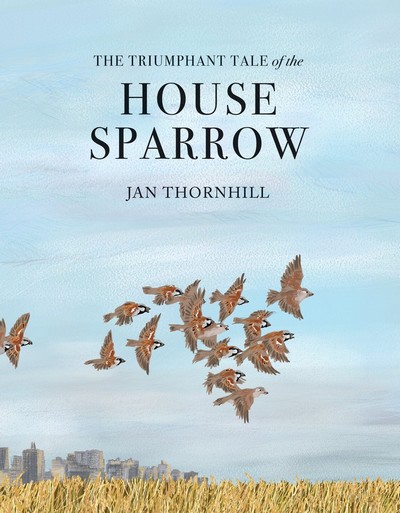I was surprised and delighted by the adulty appeal of Jan Thornhilll’s The Triumphant Tale of the House Sparrow … technically a picture book (with wonderful illustrations) but the kind that bears reading by all ages for a sort of Coles Notes (do they still exist?) version of a subject that can then be pursued in longer form if you need/want more info. Though, honestly, there’s plenty here, enough that after reading it will surely be impossible to look at this bird quite the same way.
♦
Given the title, and the opening sentence…
“Behold the most despised bird in human history.”
… we can (rightly) assume there will be some adventurous backstory to follow, i.e. how did it get from Most Despised to Triumphant?
 Also, and not that I think about sparrows a lot, but I didn’t know they were so universally (and for thousands of years) disliked. I assumed some people just didn’t like them in the way some people don’t like clowns. (Which is completely understandable.)
Also, and not that I think about sparrows a lot, but I didn’t know they were so universally (and for thousands of years) disliked. I assumed some people just didn’t like them in the way some people don’t like clowns. (Which is completely understandable.)
But no. It’s much bigger than that and, most interesting of all, their dislikeability has a lot to do with us, with our lifestyle. Because what we know for sure is they love to hang around us, like those friends who think we’re all having such a good time that they forget to go home.
This wasn’t always the case.
What happened was, we invented agriculture.
We began growing fields of grain and the sparrow, a bird that used to migrate in search of food, suddenly didn’t need to leave town so it stayed and ate that nicely planted all you can eat buffet. It came into cities and towns too, because we had horses that were fed buckets of grain. And it hung around our houses because of crumbs from tablecloths shaken out the back door, and several other surprising sources. Long story short, it became a house sparrow.
And we got cranky.
In Egypt the sparrow surplus was handled by using them as pet food. (Often found in the mummified stomachs of beloved animals.)
In Germany there was a sparrow bounty, a required number of heads had to be handed in or fines were imposed.
In China people were encouraged to bang pots twenty four hours a day in grain fields to stop the birds from landing, which worked exceptionally well… so well in fact that zillions of birds fell from the sky, exhausted and dead, and the crops died from an infestation of bugs that would have normally been eaten by the sparrows.
In cities they were noisy and just plain bothersome. In one incident, a single sparrow found its way into a large hall where a Guiness-records-sized domino display had been set up with millions of dominos… the sparrow landed and over 20,000 toppled over before they could stop the domino effect. But the bird was still in the building and naturally they worried about the other ten trillion dominos so they hired a professional hunter to come and shoot the bird, which is now stuffed in a museum. (The bird not the hunter.)
In a way, the sparrow’s biggest crime is its adaptability and how its population tends to increase along with our own. (Though we seem not to complain the same way about people numbers.)
However, mysteriously, and for some very many years now, sparrow numbers have been in decline. The Netherlands, for one, has declared them a protected species and, as Jan Thornhill points out, this might well beg some attention:
“Because the House Sparrow normally lives its whole life in a very small area, it can be a living indicator of pollutants in that place. To scientists, it is just like a canary in a coal mine — except that coal mine is our urban environment. Since the House Sparrow lives where we live, wouldn’t it be smart to figure out why it’s disappearing? What if the culprit is something that is as unhealthy for humans as it is for the House Sparrow?”
I think this book, generally, deserves all kinds of attention, not only as it relates to house sparrows, but what it represents in how we so often look at nature, what’s taken for granted, the problems we ourselves have created and now blame on the natural world, much of which is merely doing its best to tolerate us.
♦
The picture book format works well because the amount of text is just right for that Coles Notes gleaning. Any less wouldn’t do the subject justice. But it’s also too much for a picture-book age child to absorb on their own, so it becomes ideal as a read-aloud-and-discuss. Followed, of course, by a sparrow finding expedition, photographs, drawings, and chirping!
So much to love here.
Also, would be brilliant in schools. (Do they still do nature as a subject?)
♦
Purchased at Books Galore, in Port Perry.
Support indies!!
Okay, okay, okay…
hahaha! I thought as we’re more or less done with squirrels we could work on the next agenda item. CHIRP!!!!!
hahahahahahahaHA back at you. As it happens, since the woman who had a seed bell hanging on her clothesline directly outside our bedroom has moved away, the sparrows don’t wake me in the morning. (Knock on wood.)
Ah, interesting. This is what the book talks about, how closely sparrows are connected to our lifestyle. We change, they change.